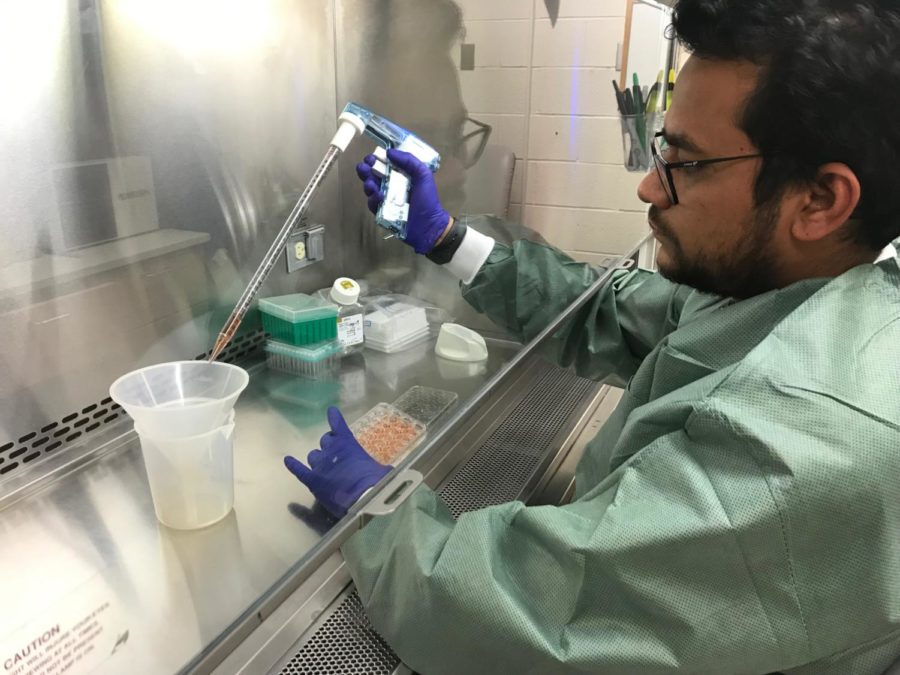Research of viral infections in swine to answer veterinary questions
October 2, 2019
Bailey Arruda is an assistant professor in the veterinary diagnostic and production animal medicine department and focuses her research on viral infections in swine.
Arruda is an Iowa State alumna. She graduated in 2011 from the College of Veterinary Medicine and received her doctorate in veterinary pathology from Iowa State in 2014.
Shortly after receiving her doctorate, she took the position of assistant professor at Iowa State as a diagnostic pathologist.
“As a diagnostic pathologist, I assist in the diagnosis of disease,” Arruda said. “[…] I am one of many other diagnostic pathologists that teach in a rotation course for fourth year veterinary students that provides both lecture case-based material and hands-on, practical experience that will provide a foundation from which students can investigate, prevent and treat disease.”
Arruda’s continuous research is focused on emerging diseases found in swine. Those diseases include porcine astrovirus type 3, porcine teschovirus and porcine sapelovirus. All three of the diseases are similar to polio in humans, as they cause weakness and paralysis in the swine.
“My primary objective is to spearhead projects that solve problems and provide meaningful answers to veterinarians and producers with the end goal of improving animal health and well-being,” Arruda said.
To conduct her research, Arruda puts together teams of people to work together toward their common goals. Arruda said she relies heavily on Iowa State graduate students for assistance with various aspects of the research, such as sample collection and data analysis.
“I commonly achieve [my objective of research] by forming collaborative research teams from a diverse background,” Arruda said. “Including a board-certified large animal veterinary surgeon and theriogenologists to epidemiologists and molecular virologists.”
Arruda said she also interacts with undergraduates of Iowa State. Arruda and her teams recently finished a field study for atypical porcine pestivirus, the cause of congenital tremor in swine.
“It’s a crazy disease if you really sit down and you think about it,” Arruda said. “These pigs come out and they shake when they move […] it was a really interesting and fun time to really delve into that.”
During the field study, Arruda said she made frequent trips to the farm with Amberly Jergens, an animal science major at the time and now a first year veterinary student.
Gaurav Rawal, graduate student in the veterinary diagnostic and production animal medicine department, and Franco Matias Ferreyra, a veterinary pathology graduate student in the veterinary diagnostic and production animal medicine department, are a part of Arruda’s research team.
Rawal started work with Arruda early in 2017 but was hired by Arruda’s husband, Paulo Arruda, who is also in the veterinary diagnostic and production animal medicine department. Matias Ferreyra started his masters degree with Paulo Arruda and then joined Arruda’s research project.
Matias Ferreyra said he was always interested in viruses and pathology and wanted to work with new viruses as it is more appealing to him.
“You can go and tag along with research teams with viruses that are well known; to me they don’t have the same kind of feeling of just looking for new stuff, for new viruses, that may be affecting the animals,” Matias Ferreyra said. “It’s an uncharted place, you study that; I think it’s more appealing. You need to be very curious about that.”
For the research, Rawal’s job is to collect samples for study to find what’s unsolved or missing. He also helped with some lab work.
Matias Ferreyra participated in a wide variety of areas for the research including using diagnostic techniques to detect if the virus in present in samples.
“We were able to answer some of the veterinary’s questions,” Rawal said. “For example, for the porcine astrovirus type 3 we were able to find out the clinical science of the virus; we were also able to understand the epidemiology of the virus.”
The viruses the team work with can affect all animals, including humans. The team focuses on ways to prevent the diseases.
“If in the future our research helps to understand human diseases and just to extrapolate that knowledge — I think it’s worth it,” Matias Ferreyra said. “[…] being engaged with research, saying, ‘you know, no one has done that before’ and just gain a little bit more knowledge. It’s also nice to study in here but it’s also nice to go outside and just be with producers. Ask them what they think of the disease, have that interaction.”
The research team spends a lot of time in the laboratories, but with the focus of their research, they are able to explore new environments such as farms, where they communicate with even more people.
“There’s a lot of meaningful information to get from the interactions with people that are on the farm, farm managers and workers as well as the attending veterinarian on those farms,” Arruda said.
The research Arruda and her team conduct is complex, as there are several aspects that all play a part in the research.
“Our research is multifaceted,” Arruda said. “[The research] commonly includes field studies to better understand how a virus interacts with a population of pigs, experimental studies that provides useful information on how a pathogen interacts with an individual animal in a controlled environment and diagnostic assay development to monitor pathogens at both the population and pig level.”
Arruda said all the approaches used in the research provide pivotal information to prevent, mitigate and control infectious diseases in swine.
Rawal said it’s important to have a team for this kind of research, as they need a lot of people. No one can do all of the research and experimenting alone.
Arruda said her journey with veterinary medicine began when she was just six years old with a small microscope. Almost thirty years later, Arruda is now working with more elaborate microscopes in the largest and one of the most progressive diagnostic labs in the world.

















